 |
SMITH & DAVIES LTD |
 |
SMITH & DAVIES LTD |
| Smith and Davies had its beginnings back in 1927 with Glyn's father Alun Tyler-Davies and Alun's step-father, Len Smith. They bought a Model T Ford to take the cream to the dairy from Len's Tauhoa dairy farm. Alun's son, Glyn Tyler-Davies said: "My father used to have to hook up a horse to it and help pull it over the dirt tracks. Once he got to the metal roads, he'd tie up the horse and deliver the cream in the Model T." Pretty soon he began to deliver the milk and cream for the other farmers in the area and he ended up with a depot on the farm and four trucks. | 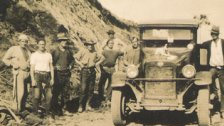 |
Alun Tyler-Davies was running the business on his own within a couple of years (his step-father preferring to run the farm), and soon moved its base from the farm to the local Rail Head at Kaipara Flats, about 12kms from Warkworth. Operations increased with the distribution of goods from the rail to the surrounding districts, the work including a rural mail run the Listers Pioneer Mail Service - that stayed in the company for 41 years until it was sold to an owner/operator in the 70's.
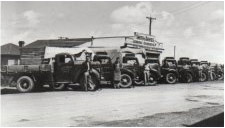 |
At its height the operation in the 1930's Alun had trucks scattered all over the mid and upper North Island extending its transport services to include Coal & Firewood, Bulk Fertiliser, Roading Fill & Aggregate, wool and other general goods. At one point Alun had about 20 trucks working as far north as Kaitaia. Glyn said "The big adventure for me was to go with my father every fortnight when he'd go around and pay the drivers. Most of them were on the roadworks so it was always back to the pub at five o'clock to shout all the Ministry of Works overseers. That was the only part I didn't like waiting around outside pubs." |
These operations were based from the existing depot in Kaipara Flats. Alun Tyler-Davies had also built up a branch at Helensville and a new depot at Devonport, on Auckland's North Shore, prior to World War 2. In those days Devonport was a bustling place "It was State Highway One. Everything used to go across (to and from Auckland city) on the ferry."
By 1953 the decision had been made to move the company headquarters from Kaipara Flats to Devonport. The Helensville Branch had already been sold to Kaipara Dairy Company just after World War 2 and with the move, Alun sold the Kaipara Flats business in 1952 to a couple of his truck drivers (with the exception of the Rural Mail Service).
The family moved halfway to Auckland to Orewa. And that's how the business was too, half city, half country: "In the summer we'd cart Fertiliser and Roading Aggregate around the lower North. Then in the winter, all the trucks would go back to Devonport and cart firewood and coal all around the North Shore."
Glyn started working for the company in 1958. "As soon as I was 18 I got my heavy traffic licence and I started driving a 1953 OLB Bedford tipper".
The 1960s brought a huge change for Auckland and for Smith and Davies: The Auckland Harbour Bridge was obviously going to shift the emphasis completely off Devonport and the ferries and open up the north. First, Smith and Davies got a lot of work out of the harbour bridge construction job carting metal to the site, much of it barged in to Devonport and Birkenhead. Then it had to take account of the changes the bridge was going to make: The company moved to Northcote, close to the northern side of the bridge.
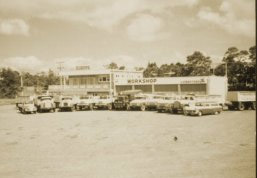 |
At one stage the Devonport operation had run about 14 trucks but "as my father started to get a bit sick of it", the fleet shrunk and by the time of the shift into an old Northcote service station, in 1966, there were nine trucks. "Then I built it up from there," said Glyn who took the company into contracting work and concentrated the transport arm on the associated earth-moving and bulk metal cartage work as its core business. He began to apply his own philosophy to the business, one he sticks with still: "What we do is we tend to go after jobs that are different. If you want to cart metal-chip along the road for Winstones or somebody like that, you end up with a nice shiny truck, but you don't make any money. If you tend to cart the odd-ball stuff like we cart a lot of stuff for Waste Management, we cart rock, we cart scrap steel, we cart all of what I would consider the harder-type work. But there's money in it." |
Under Glyn's direction Smith and Davies' first major contracting job involved doing all the earthworks for Auckland's first shopping mall, Lynnmall and New Lynn. It was about the same time, in 1969, that Smith and Davies bought the first of many, many Mercs a little 1418 model, bought "because my father was always keen on Mercedes."
In 1970 Smith and Davies added log transport to their operation at the start of our relationship with Carter Holt Harvey Ltd (then Henderson and Pollard Ltd) which lasted over 29 years. The company has grown concentrating in these areas and in early 1980 purchased additional land in Albany which has been developed into commercial units. Associated companies have also been formed to purchase land to assist company operation in Whangarei, Helensville and Wiri.
| The Northcote premises was redesigned and modernised
in 1997, to keep up with the changing times and to create
a healthy work environment for the Smith and Davies
staff. They moved into the new millenium with over 60 trucks- all Mercedes. The last time the company bought another make was about 13 years ago when it bought one Kenworth. |
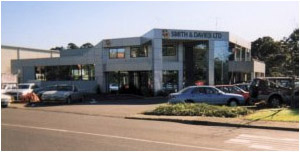 |
As for the company's progress Glyn summed it up briefly with a "we've had our ups and downs since I got involved in 1970."
The "ups" include working in some way on "just about every major Auckland construction" project.
| What he has contrived to make money out of though is supplementing his truck-oriented contracting work with dredging work on a grand-scale: "We did $3million worth of work for the America's Cup. We made what we call mud-crete. We dig mud off the bottom of the seabed, take it to the shore, mix 10% cement with it and then we use it to reclaim the land. "With Fletchers, we built an island on the Auckland waterfront. Fletchers put the wall around the outside we put all the stuff in the middle 120,000 metres of it." The company did a similar amount of dredging for the Bayswater marina: It dredged around 120,000 metres and then "we stabilised the mud a bit like putting a crust on a pie. We just went around with an excavator and hoed lime into it 600mm layers and then put another layer on top of that. The whole thing's sitting there on a big jelly." | 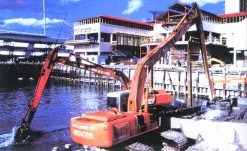 |
The biggest "down" in the last three decades was, without a doubt, from 1988 to 1991, in the wake of the share-market crash. "It was bad enough that we took just under a million dollars in bad debts, but what the worst thing was, the people who went broke owing us the money were lost clients: Wilkins & Davies was one you know we were probably doing $2million worth of work a year for them."
Glyn had what he terms his fallback positions: "The trouble was every time you thought you'd just about solved the problem, someone else would tip over. Like I think Wilkins and Davies went one week and that was about $250,000 and Angus went the next week and that was a couple of hundred thousand. Things were getting pretty tough that's when I realised we had to put some staff off. We just couldn't keep carrying them any longer we'd done it for a couple of years. It was pretty disappointing for me this company has never put anyone off in all the time it had been going."
The normal practice of retaining 10% of a contract price until six months after completion of a contract is usually a hurtful thing but at that point it was a help: "That was probably part of the reason why we survived -because we had this money sitting out there. OK we lost quite a bit of it, but we also had something coming in." And, despite reeling from absorbing such big losses, Smith and Davies retained and maintained its entire fleet: "And because we'd kept our fleet in reasonable condition, when things picked up we came right in a real big way. We had record years for the next couple of years we had very little opposition."
That was one particularly Auckland-ish hazard. There are others starting out with dealing with rush hour traffic: Our depot's a major! If we don't get our trucks out of it by seven in the morning it takes 20 minutes just to get half a k up the road to the lights. The trouble is a lot of our work comes in over the phone so we can have every truck booked out and it rains overnight and we've probably lost work for 80% of our trucks. So you get on the phone, ring around and you'll get someone who wants two here and so on." But by that time, the rush hour has started and the trucks can spend the next hour caught up in traffic.
Being such an Auckland company means that: "the thing is, if Auckland's going okay, we're going okay. We're currently involved in just about every main contract in Auckland whether as a contractor or a sub-contractor." That includes the Manukau waste water treatment scheme, northern motorway extensions and the removal of what's so far amounted to 60,000 metres of contaminated landfill from a Green Bay retirement village site.
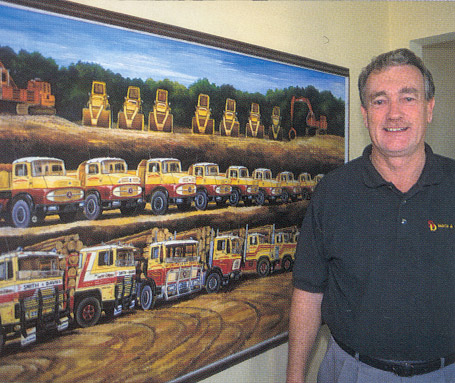 |
These days, it's the overall direction of the company
and its special projects that Glyn Tyler-Davies likes to
concentrate on, as he confronts turning 60 next year and
aims to ease up on Smith and Davies duties: "I'm not
married to the business and I've got some very good
people working for me." Among those key staff that he and his wife Noleine (whose Dad used to drive for Alun Tyler-Davies) have around them are plenty of family members. Like daughter Donna, who runs the accounts for the logging operation and like nephews Graham and Steven MacKinnon. |
"I'm trying to pull back from things a bit the things that interest me are the jobs that are different." Like the Wanganui River rehab job, the mud-crete projects and forging new joint-venture projects. I get involved in the pricing of the work quite a bit. Winter in our type of business is always our worst time of the year: If we have a good winter we have a good year. So at this time of the year I'm carefully watching the tenders as they come up, looking for what will give us work for the winter and those are the ones I chase.
"When you've got a staff of over 100 you've got to be careful. We only have 20% casual, the rest are permanents. And we don't put staff off well, the only time we ever put anyone off was in '91 when things got real bad and we had to put off 12 drivers. But we hired them back within six months. And they were certainly exceptional circumstances. I hope it'll never happen again I think we're all a bit wiser. And I've got another fallback position now I learnt then how to survive for three years, now I think I could survive five."
(Excerpts taken from an article on Smith and Davies printed in the NZ Truck and Driver magazine, June 1999)